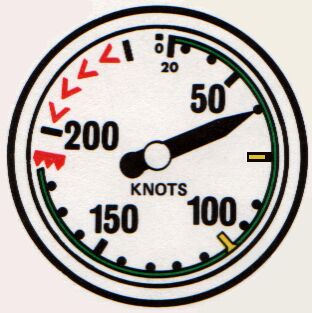
|

|

|

|

This is a list off all the different airspeed ranges that I could find on the AH-1. Some are for the AH-1G while others apply to the AH-1F. Different model are so noted in the list. If any of the Instructor pilots who happens to see any errors I would greatly appreciate a E-mail describing the error I made. This list is not endorsed by the U.S. Army or Bell Helicopter but is provided for information and entertainment only.
| Airspeed (kts) | Limitation or Requirement |
|---|---|
| 0 | Ditching airspeed and minimum indicated airspeed |
| Brisk walk | Hover taxi speed |
| 15 | Maximum gust spread to start aircraft (observed not forecasted) |
| 10 - 20 | Transverse flow effect is greatest at this A/S thus greatest vibration due to unequal drag in the fore and aft portion of rotor disk because of reduced downwash angle at the front of the disk thus increase angle of attack thus increase lift thus less induce drag since less downwash angle as compared with the rear portion of the rotor disk. |
| 16 - 24 | Airspeed at which you will usually achieve effective translational lift, but the nose up (if allow then right roll) and left yaw (due to tail rotor thrust) will not occur due to SCAS |
| 25 | Airspeed indicator and (I) Vertical Speed indicator inaccurate below this A/S |
| 26 - 32 | Weapon firing in this A/S range will result in degraded accuracy if K747 blades are installed. |
| 30 | Maximum for rearward flight because of torsional instability due to air restricting the overboarding of exhaust (Mod S) |
| 35 | Maximum for sideward flight. |
| 40 | If below on hydraulics dual failure, cyclic feedback forces become unmanageable.
Max A/S to start aircraft. |
| 45 | Only applicable for G model and Modified S Cobras in which it is a max wind velocity for opening canopy on the ground with 40 KIAS max A/S to open canopy to the intermediate position while in flight during smoke and fume elimination. |
| 50 | Touchdown at or above on hydraulics failures.
Maximum reading on Low Airspeed indicator. |
| 55 - 60 | Maximum endurance (not used in IFR because of poor handling characteristics). |
| 60 | Minimum rate of descent.
Maximum rate of climb due to minimum drag thus minimum power required. |
| 60 - 80 | Best autorotational characteristics. |
| 70 | N/A (however in the G model it was max A/S below 6400 RPM (97%) because of retreating blade stall |
| 80 | Standard climb A/S (500 fpm) and bailout A/S if A/C is in control. |
| 90 | Max A/S for copter instrument approach depicted holding pattern and copter approach.
Best glide distance with wing stores. |
| 100 | Maximum A/S above 88% torque, maximum A/S with SCAS off.
Recommended turbulence penetration airspeed. Recommended airspeed for instrument approach and IFR holding. Cambered vertical fin becomes effective. |
| 120 | Maximum for steady state autorotation.
Must put in cyclic input to take control of SCAS at engine failure. Emergency decent power off maximum A/S. |
| 130 | Maximum for flight with wings removed (only applicable for G model). |
| 150 | Maximum for TOW firing.
Maximum for practice autorotation and/or rapid throttle reductions at greater than 150 KIAS and 62.5% torque (35 PSI). Maximum limit for indicated torque grater than 62.5%. |
| 160 | Vne with cross tube fairings removed (only applicable to G model) |
| 170 | Vne with TOW installed or above 9500 lbs. gross weight. |
| 180 | Vne with any rocket pods installed |
| 190 | Vne clean. |
|
|
|
|
| Updated: 12 January 2008 | Born on 21 October 1998 |